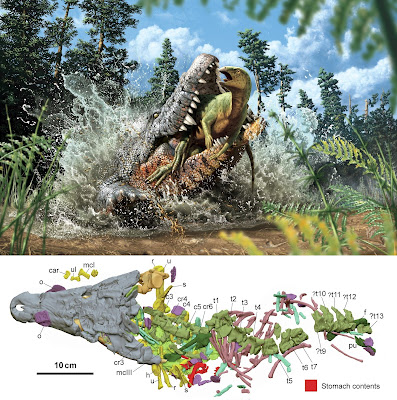 |
| Confractosuchus sauroktonos White, Bell, Campione, Sansalone, Brougham, Bevitt, Molnar, Cook, Wroe & Elliott, 2022 |
Highlights:
• Description of a new early-branching eusuchian from Australia.
• New taxon named Confractosuchus sauroktonos gen. et sp. nov.
• Tomography scans revealed its last meal was a juvenile ornithopod dinosaur.
• Morphometric analysis identifies Confractosuchus as a macro-generalist.
Abstract
Crocodylians are among Earth’s most successful hyper-carnivores, with their crocodyliform ancestors persisting since the Triassic. The diets of extinct crocodyliforms are typically inferred from distinctive bite-marks on fossil bone, which indicate that some species fed on contemporaneous dinosaurs. Nevertheless, the most direct dietary evidence (i.e. preserved gut contents) of these interactions in fossil crocodyliforms has been elusive. Here we report on a new crocodyliform, Confractosuchus sauroktonos gen. et sp. nov., from the Cenomanian (92.5–104 Ma) of Australia, with exceptionally preserved abdominal contents comprising parts of a juvenile ornithopod dinosaur. A phylogenetic analysis recovered Confractosuchus as the sister taxon to a clade comprising susisuchids and hylaeochampsids. The ornithopod remains displayed clear evidence of oral processing, carcass reduction (dismemberment) and bone fragmentation, which are diagnostic hallmarks of some modern crocodylian feeding behaviour. Nevertheless, a macro-generalist feeding strategy for Confractosuchus similar to extant crocodylians is supported by a morphometric analysis of the skull and reveals that dietary versatility accompanied the modular assembly of the modern crocodylian bauplan. Of further interest, these ornithopod bones represent the first skeletal remains of the group from the Winton Formation, previously only known from shed teeth and tracks, and may represent a novel taxon.
Keywords: Confractosuchus sauroktonos, crocodyliform, crocodylians, morphometrics, Winton Formation, Cretaceous, ornithopod, stomach contents
Systematic Palaeontology
Crocodyliformes Hay 1930
Mesoeucrocodylia Whetstone & Whybrow 1983
Neosuchia Benton & Clark 1988
Eusuchia Huxley 1875
Confractosuchus gen. nov.
Confractosuchus sauroktonos gen. et sp. nov.
Diagnosis: Neosuchian with the following autapomorphies: two pairs of longitudinal ridges on the rostrum that appear to span the prefrontal and lacrimal bones and terminate mid-rostrum; strongly regionalised vertebral assembly consisting of incipiently procoelous cervicals (c3–5), strongly procoelous thoracics (t1–2), incipiently procoelous (t3, ?t13) and amphicoelous mid-thoracic vertebrae (t4–7, ?9–12) (Fig. 2).
Etymology: Confractus (‘broken’, Latin), referring to the shattered concretion in which the holotype was preserved, and suchus (derived from the Greek, Soûkhos), referring to the Egyptian crocodile god Sobek; sauros (‘lizard’, Greek), a common word used as a suffix for dinosaur genera, and ktonos (‘killer’ Greek) referring to its abdominal contents.
Conclusion:
Here, we have described a new crocodyliform, Confractosuchus sauroktonos gen. et sp. nov., from the Winton Formation of central Queensland Australia. Its last meal, a juvenile ornithopod dinosaur, was discovered in its abdominal cavity. These gut contents oddly represent the first recorded skeletal remains of ornithopods from the Winton Formation and may represent a novel taxon. The abdominal contents provided a unique opportunity to verify predictions of feeding behaviour, ascertained from a morphometric analysis of the skull. The prediction of Confractosuchus as a macro-generalist or, at the very least a generalist feeder via GM was substantiated by the ornithopod it consumed.
Matt A. White, Phil R. Bell, Nicolás E. Campione, Gabriele Sansalone, Tom Brougham, Joseph J. Bevitt, Ralph E. Molnar, Alex G. Cook, Stephen Wroe and David A. Elliott. 2022. Abdominal Contents reveal Cretaceous Crocodyliforms ate Dinosaurs. Gondwana Research. In Press. DOI: 10.1016/j.gr.2022.01.016





